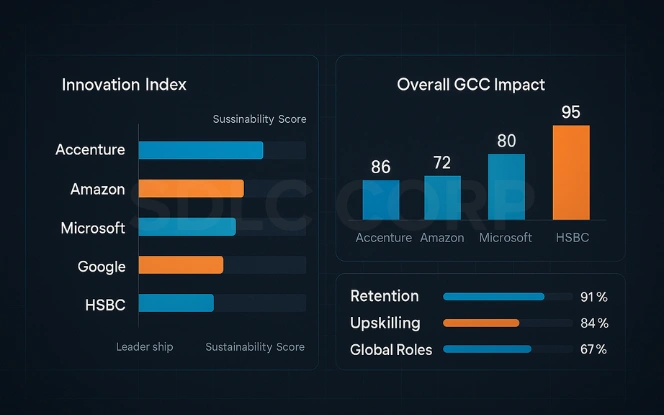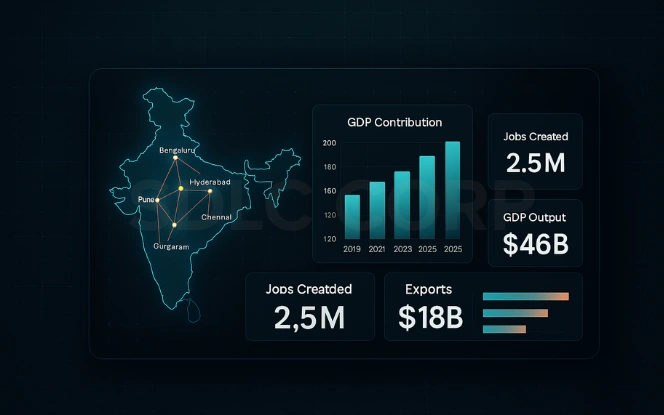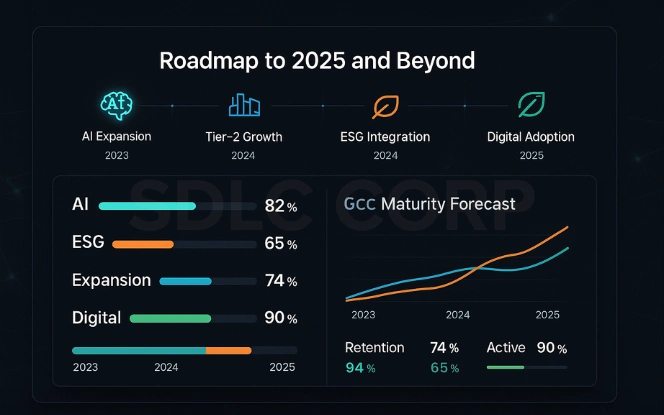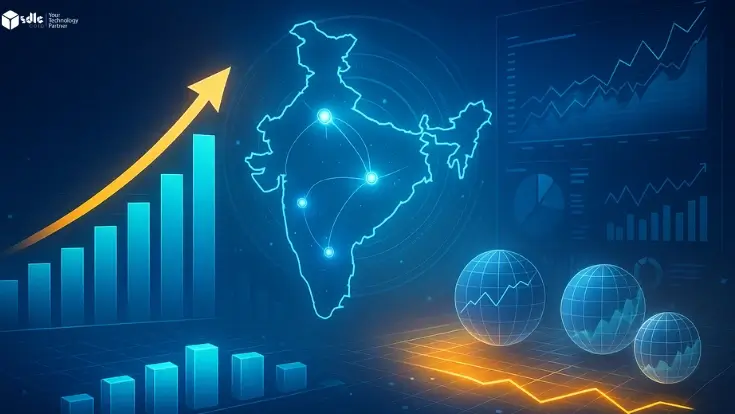Introduction
Top GCC India operations have become the foundation of enterprise innovation. These Global Capability Centers (GCCs) in India now serve as strategic partners for global corporations, managing everything from digital transformation to advanced research and product development. Once created for operational efficiency, they now drive innovation, scalability, and competitive advantage across industries.
According to NASSCOM, India hosts over 1,600 Global Capability Centers employing millions of professionals across technology, finance, and engineering. Their evolution from process hubs to innovation engines marks a significant milestone in India’s digital rise. With strong infrastructure, deep talent, and government support, these centers represent the future of India capability center transformation.
India’s GCC Revolution - Building a New Backbone

The rise of Global Capability Centers in India marks a major change in how global companies plan, deliver, and innovate. Earlier, these centers mainly focused on reducing costs. Today, they have become independent business units that drive revenue, digital transformation, and strategic decision-making. Many global enterprises now depend on their Indian GCCs for leadership, technology advancement, and product excellence.
Key Developments Driving Growth
- End-to-end product ownership:
Indian GCCs now manage products from idea to launch. This full ownership reduces dependency on parent headquarters and allows faster, more flexible innovation. - Advanced engineering labs:
These labs help teams test and improve digital products before they go global. They focus on artificial intelligence, automation, cybersecurity, and cloud-based development to ensure high quality and scalability. - Leadership and talent development:
Many GCCs invest in leadership programs that build governance skills, business foresight, and innovation agility. This helps Indian professionals take on global leadership roles.
Policy Support and Economic Impact
Government initiatives like Digital India and Startup India have encouraged long-term investments and supported the GCC ecosystem. This strong policy framework has helped India attract global corporations and expand its digital infrastructure.
Today, the GCC sector contributes nearly 46 billion dollars a year to India’s economy and continues to grow at over 10 percent annually. These centers now serve as digital incubators and transformation catalysts, delivering innovation, cybersecurity, and cloud solutions worldwide.
For an in-depth overview of their foundation, explore What is GCC?, which breaks down the structure and purpose of capability centers.
Catalysts for Business Transformation

Top GCC operations in India are no longer seen as back office units. They have become strong growth engines that shape business strategy and digital transformation. Each Global Capability Center now plays an active role in decision making, technology development, and process improvement. These centers are key drivers of enterprise modernization and innovation.
Key Transformation Drivers
- Automation and AI adoption:
More than 70 percent of GCCs now use artificial intelligence and automation to improve operations. These tools help reduce manual effort, increase accuracy, and enhance customer experience. They also allow teams to focus more on innovation and quality improvement. - Cloud first architecture:
Most GCCs operate on secure multi cloud environments that improve global scalability. This approach supports flexible deployment, better data protection, and faster adaptation to business needs. It helps companies stay connected and resilient worldwide. - Data analytics for strategy:
Data analytics has become the foundation of decision making. Advanced tools help GCCs predict trends, analyze performance, and make data backed choices. Many centers have seen a 30 percent increase in forecasting accuracy, allowing smarter business planning. - Agile and continuous delivery models:
GCCs use agile practices and DevOps frameworks to ensure quick releases and stable products. This continuous delivery model helps teams deliver faster while maintaining high quality standards.
India’s Expanding Role in Global Transformation
These developments have shifted global enterprises from reactive operations to proactive innovation. India’s GCCs are now at the center of research, design, and engineering. Companies such as JP Morgan, Shell, Microsoft, and Target rely on their India-based GCCs for innovation, cybersecurity, and product development.
To learn more about how global firms structure their centers, explore AI-First Global Capability Centers, which explains proven models for long-term success.
Digital Acceleration and Innovation - Building for 2025 Readiness

Digital acceleration is now at the core of every Global Capability Center in India. These centers have grown from support units into powerful technology hubs that drive innovation, efficiency, and growth. India’s GCCs are leading global adoption of artificial intelligence, blockchain, the Internet of Things, and cloud-based platforms. They play a key role in helping organizations become more digital, data-driven, and future-ready.
Examples of High-Impact Innovation
- Banking and financial services:
Banking GCCs are using AI-based systems to detect risks and prevent fraud. These solutions have helped reduce fraud incidents by nearly 25 percent, improving security and customer trust. - Manufacturing and industrial operations:
Manufacturing centers are using IoT sensors and digital twins to monitor performance in real time. These tools help reduce equipment downtime by up to 18 percent and improve maintenance efficiency. - Retail and e-commerce:
Retail GCCs are applying real-time data models to improve supply chain forecasting and pricing. Better demand prediction has led to more accurate inventory management and higher profit margins.
Responsible and Sustainable Innovation
GCCs in India are not only innovating fast but also doing it responsibly. Many have introduced clear AI ethics policies that promote fairness, transparency, and accountability. Several centers have also built innovation councils to encourage design thinking, creativity, and cross-team collaboration.
Sustainability is another focus area. GCCs are optimizing their data centers for energy efficiency and moving toward carbon-neutral operations. These steps align with India’s capability center digital roadmap for 2025, which promotes inclusive innovation, green computing, and strong AI governance.
To see how artificial intelligence continues to accelerate performance, refer to AI-First Global Capability Centers GCCs (UK).
Talent and Leadership - India’s Enduring Advantage

India’s greatest strength lies in its people. The country’s growing talent ecosystem continues to power the success of Global Capability Centers. Each capability center relies on India’s vast pool of skilled engineers, analysts, designers, and business leaders. Together, they drive innovation, technology adoption, and transformation at a global level.
Global Capability Centers in India are no longer focused only on delivery. They now invest deeply in developing people who can lead change and build sustainable innovation. Every GCC supports talent growth through structured learning, leadership mentoring, and technical certifications that prepare teams for tomorrow’s challenges.
Core Pillars of Talent Development
- Partnerships with top universities:
GCCs collaborate with institutions such as IITs, IIMs, and global universities to offer upskilling programs. These partnerships bridge academic excellence with industry demand, creating a steady flow of skilled professionals ready for advanced technology roles. - Specialized GCC academies:
Many centers run in-house academies that train employees in cloud computing, AI ethics, cybersecurity, and data privacy. These programs help professionals stay aligned with global digital standards. - Leadership mobility programs:
Structured mobility programs allow employees to take on cross-border assignments and build global perspectives. This nurtures future-ready decision makers who understand both local and international business environments.
Knowledge Sharing and Leadership Impact
Mentorship programs and innovation councils ensure that best practices and new ideas are shared across teams. This approach transforms GCCs into long-term innovation ecosystems instead of transactional delivery units.
Indian professionals are now taking on leadership roles that shape the future of global enterprises. According to Deloitte’s 2024 report, more than 35 percent of global GCCs are led by Indian-origin executives in key positions. These leaders influence transformation strategies for some of the world’s largest companies.
To learn more about leadership frameworks and high-performance culture, explore Build a High-Performance Global Capability Center GCC UAE, which highlights advanced models for developing global leaders.
Ten Centers Driving Measurable Impact

The Top global capability centers India list demonstrates how technology and leadership combine to shape business success. Each Global Capability Center (GCC) listed below showcases excellence in execution, innovation, and strategic alignment.
Prominent examples:
- Accenture India GCC: Leading enterprise transformation through AI-driven automation and design thinking.
- JP Morgan Chase GCC: Developing secure, scalable fintech systems to enhance customer experience.
- Microsoft India GCC: Driving global product engineering for Azure and collaboration tools.
- Google GCC India: Focusing on data analytics and sustainable computing initiatives.
- Amazon GCC India: Innovating in predictive logistics, AI forecasting, and retail technology.
- Goldman Sachs GCC: Automating financial governance and regulatory processes.
- Shell GCC: Enabling renewable energy transition through digital engineering.
- HSBC Technology India: Strengthening global banking systems with AI and blockchain.
- PepsiCo GCC: Leveraging data science to optimize production and supply networks.
- Walmart Global Tech India: Reinventing retail through omnichannel architecture and cloud adoption.
Each center validates how India’s ecosystem supports digital maturity and transformation leadership. For deeper insights, explore High-Performance Global Capability Center GCC US.
The Future of Work - Flexible, Secure, and Measurable

Work design within Global Capability Centers has evolved toward flexible, measurable frameworks. Top GCC India operations now prioritize hybrid models where agility, transparency, and security coexist seamlessly.
Emerging workplace practices:
- Cloud-based collaboration tools improving real-time performance.
- Agile sprints and DevOps pipelines enabling faster release cycles.
- Cyber resilience frameworks mitigating digital risks.
Moreover, teams focus on psychological safety, promoting inclusion and creativity. Employees can innovate freely while adhering to structured governance models. Consequently, productivity and retention rates have improved across the GCC landscape.
This hybrid work culture ensures sustainability while reducing burnout. Therefore, the future of work within India’s GCC ecosystem blends human creativity with digital precision – setting the standard for global enterprises.
Economic Contribution - Wider Value Creation

The economic influence of Global Capability Centers goes far beyond corporate growth. They are major contributors to India’s GDP, employment, and regional development.
Major Contributions
- Over 46 billion dollars in annual economic output, as reported by NASSCOM in 2024.
- Employment for nearly 2 million professionals, with consistent yearly growth.
- Expansion into Tier 2 cities, driving local job creation and balanced urban development.
In addition to direct economic impact, GCCs fuel collaboration with startups, universities, and research institutions. They fund digital skilling programs that strengthen local talent pipelines and promote entrepreneurship. Many centers also engage in community outreach, supporting education, innovation labs, and sustainability projects.
This ecosystem effect creates inclusive and self-sustaining regional economies that connect talent, technology, and investment. By doing so, GCCs make a measurable difference to both national prosperity and global competitiveness.
India’s GCC network has become a cornerstone of the digital economy, linking business resilience with social progress. The ongoing expansion of these centers ensures continued innovation and stable long-term growth.
For detailed insights into setup and operational costs, refer to How Much Does It Cost to Set Up a Global Capability Center.
Risks and Controls

Every Global Capability Center in India faces a range of evolving challenges, from data security threats to compliance with global regulations. As operations expand across industries and regions, the need for strong risk management becomes more critical. Proactive governance helps protect data, maintain transparency, and ensure business continuity.
Core Risk Management Practices
- Cybersecurity frameworks:
Most GCCs have adopted multi-layered security systems that align with ISO and GDPR standards. These frameworks include network monitoring, controlled access, and data encryption to safeguard information. Regular security audits strengthen system resilience. - Real-time compliance dashboards:
Advanced dashboards track policy compliance and audit readiness in real time. They help detect non-compliance early, simplify reporting, and enhance operational visibility across global teams. - Workforce rotation models:
Several centers implement structured workforce rotation to reduce dependency on specific teams. This ensures business continuity and knowledge sharing during leadership or market changes. - Predictive risk analytics:
GCCs increasingly use predictive analytics to identify potential threats and inefficiencies. This approach enables early intervention and improves decision-making accuracy.
Building Global Benchmarks
Through these practices, top GCCs in India have set new standards for transparency, control, and crisis management. Their focus on digital resilience and ethical governance helps global companies operate securely in uncertain environments.
By integrating automation, analytics, and training into risk frameworks, GCCs strengthen accountability and trust. This proactive approach not only minimizes disruption but also enhances business confidence. As a result, India’s GCC ecosystem continues to be recognized as a model of stability, compliance, and operational excellence worldwide.
Roadmap to 2025 and Beyond

The future of Global Capability Centers in India is guided by purpose, sustainability, and responsible innovation. Top GCC India firms are building inclusive digital ecosystems aligned with ESG principles and future-ready AI frameworks.
Strategic priorities for 2025:
- Expansion into Tier-2 cities unlocking new talent ecosystems.
- Responsible AI adoption ensuring ethical governance.
- Renewable-powered data centers promoting environmental sustainability.
Furthermore, centers are investing in cross-industry collaborations and knowledge exchange. These measures guarantee that India capability center digital roadmap 2025 remains future-ready, inclusive, and globally aligned.
Conclusion
India’s GCC ecosystem defines the future of enterprise transformation. Each Global Capability Center in the Top GCC India network contributes to innovation, agility, and long-term competitiveness. These centers have moved beyond operational support to become strategic pillars of global business transformation.
Global Capability Centers in India combine world-class technology, leadership, and execution to deliver measurable business outcomes.
To build or optimize your own capability center, Contact us SDLC Corp for tailored strategy and implementation expertise.
FAQs
What Is Driving The Growth Of Global Capability Centers In India?
The rapid growth of Global Capability Centers in India is fueled by strong infrastructure, skilled talent, and government incentives. Top GCC India operations now manage core functions, innovation, and R&D for leading enterprises, ensuring faster transformation and scalability.
How Are GCCs Contributing To India Business Transformation?
Global Capability Centers (GCCs) enable enterprises to merge automation, analytics, and AI with strategic decision-making. This approach has transformed India business transformation through GCCs into a model for operational excellence and global competitiveness.
Why Is The India Talent Ecosystem Important For Capability Centers?
The India talent ecosystem for capability centers drives innovation and sustainability. With a workforce skilled in AI, data science, and product design, Indian GCCs deliver advanced business capabilities and leadership for global markets.
What Technologies Are Powering GCC Innovation In India?
Top GCC India centers employ AI, IoT, machine learning, and blockchain to revolutionize business processes. These technology innovation hubs India GCCs power digital transformation through automation, data analytics, and continuous delivery frameworks.
What Does The India Capability Center Digital Roadmap 2025 Focus On?
The India capability center digital roadmap 2025 emphasizes responsible AI, ESG initiatives, and regional expansion. This strategy ensures sustainable growth, ethical innovation, and India’s leadership in digital transformation.






